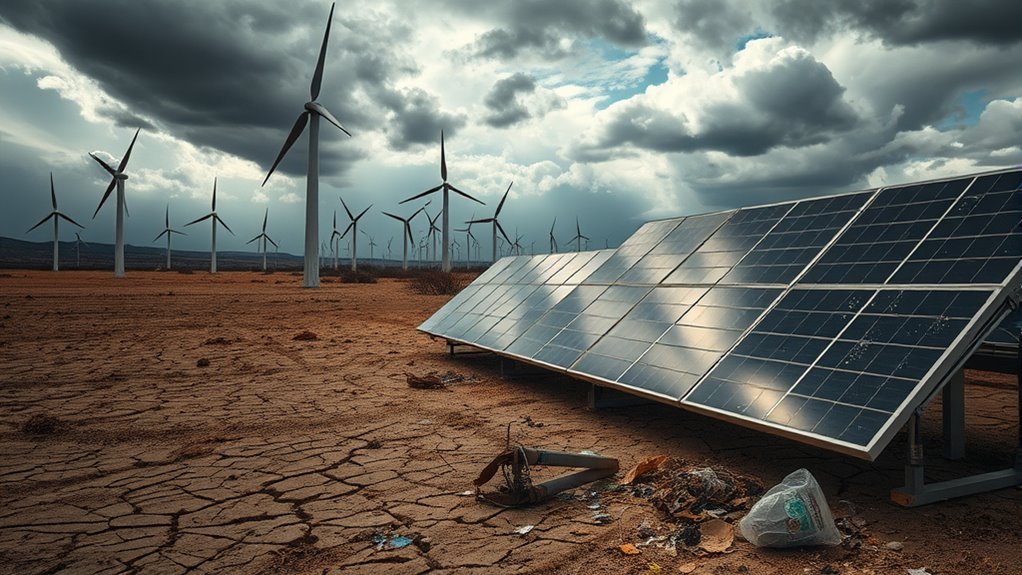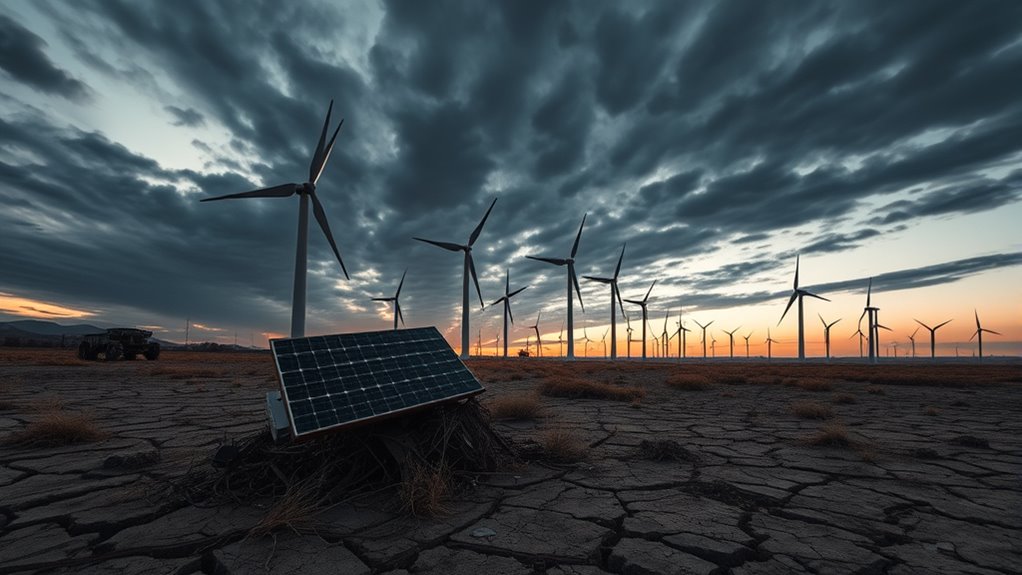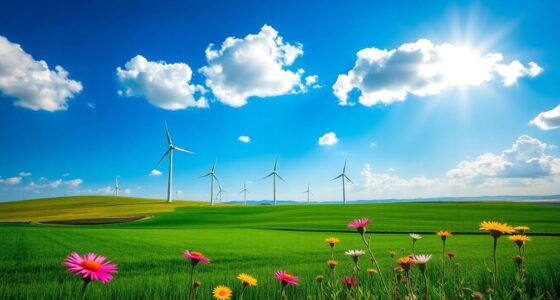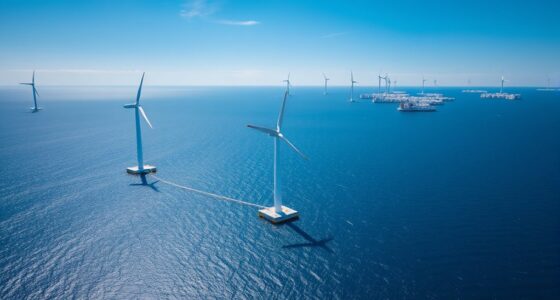While wind turbines and solar panels help fight climate change, they aren’t without issues. Their production requires rare metals like lithium and cobalt, causing land damage and poisoning water sources. Disposal is also problematic, with solar panels and turbine blades piling up in landfills and releasing toxins. Plus, manufacturing consumes lots of energy and chemicals. To understand how these hidden costs affect sustainability more deeply, explore what lies beneath the surface of green tech.
Key Takeaways
- Mining for materials like lithium, cobalt, and rare earth elements causes environmental degradation and habitat loss.
- Recycling solar panels and wind turbine blades is underdeveloped, leading to toxic waste and landfill accumulation.
- Manufacturing renewable energy tech involves high energy use and hazardous chemicals, offsetting some environmental benefits.
- Evolving regulations hinder effective waste management and responsible disposal of renewable components.
- The environmental footprint of green tech includes extraction impacts and waste challenges, requiring more sustainable practices.

As the push for greener technology accelerates, many people assume that all eco-friendly innovations are inherently good. However, the reality isn’t always so simple. Wind turbines and solar panels, often celebrated as symbols of sustainable progress, come with their own set of environmental challenges. While they reduce reliance on fossil fuels, their production and deployment can cause significant environmental impacts that are easy to overlook.
One major concern lies in the mining impacts associated with these technologies. Both wind turbines and solar panels require a variety of rare and precious metals—like lithium, cobalt, and rare earth elements—that are extracted through extensive mining operations. Such mining often leads to land degradation, habitat destruction, and water pollution, disrupting local ecosystems. The process is energy-intensive and can emit substantial greenhouse gases, ironically offsetting some of the environmental benefits these technologies aim to provide. You might not see the immediate effects, but the extraction process leaves a lasting mark on the environment, affecting communities and wildlife alike.
Waste management presents another pressing issue. Solar panels, for example, have a lifespan of about 25 to 30 years, after which they need recycling or disposal. Currently, the infrastructure for recycling solar panels is underdeveloped, leading to concerns about electronic waste piling up. When panels are discarded improperly, they can leach toxic substances like lead and cadmium into the soil and water, posing health risks to nearby communities. Wind turbines also generate waste, primarily from blades made of composite materials that are difficult to recycle. As these blades reach the end of their operational life, managing their disposal becomes a growing problem. Leftover blades often end up in landfills, where they take centuries to decompose, adding to the mounting waste problem.
Moreover, the manufacturing process for these green technologies consumes substantial energy and raw materials, sometimes involving hazardous chemicals. This initial energy footprint can be significant, especially if the energy used comes from non-renewable sources. It’s a reminder that the environmental benefits of wind and solar aren’t automatic—they depend heavily on how these systems are produced, maintained, and disposed of.
Additionally, the regulatory frameworks governing the recycling and disposal of renewable energy components are still evolving, which complicates efforts to manage waste sustainably. While wind turbines and solar panels are vital tools in fighting climate change, their environmental footprint isn’t negligible. Mining impacts and waste management are critical issues that need addressing to ensure that these so-called green solutions don’t create new environmental crises. Recognizing these challenges doesn’t mean abandoning renewable energy; it means taking a more extensive approach to developing truly sustainable and responsible green technology.
Frequently Asked Questions
How Do Green Technologies Impact Local Wildlife Populations?
You might wonder how green technologies impact local wildlife populations. Wind turbines and solar panels can cause habitat disruption, making it harder for animals to find food and shelter. They also affect species migration patterns, sometimes blocking traditional routes. While green tech aims to reduce pollution, it’s essential to take into account these effects to protect wildlife, ensuring that renewable energy solutions don’t unintentionally harm the ecosystems they seek to save.
Are There Health Risks Associated With Living Near Renewable Energy Facilities?
You might wonder if living near renewable energy facilities poses health risks. While green tech offers benefits, health concerns like noise pollution from wind turbines can affect your well-being, causing sleep disturbances or stress. Solar panels generally don’t emit noise, but the construction process might be disruptive. It’s wise to contemplate these factors and stay informed about local regulations to minimize potential health impacts when choosing to live near such installations.
What Are the Long-Term Environmental Costs of Manufacturing Solar Panels?
When considering the long-term environmental costs of manufacturing solar panels, you should recognize that manufacturing emissions contribute considerably to pollution. Additionally, you might overlook the importance of material recycling, which can mitigate waste and reduce resource extraction. While solar panels offer clean energy, their production process poses environmental challenges that need addressing to ensure sustainability. Focusing on improving recycling methods and reducing manufacturing emissions helps minimize these impacts over time.
Can Renewable Energy Infrastructure Cause Significant Land Degradation?
You might wonder if renewable energy infrastructure causes land degradation. It can lead to land use conflicts, as large solar farms and wind turbines require extensive space, potentially fragmenting ecosystems. This ecosystem fragmentation may harm wildlife habitats and reduce biodiversity. While renewables aim to protect the environment, you should consider these impacts and explore ways to minimize land disturbance, ensuring the shift to clean energy doesn’t come at the expense of natural landscapes.
How Sustainable Is the Supply Chain for Rare Earth Materials Used in Turbines?
Did you know that over 60% of rare earth elements in turbines come from China, raising concerns about supply chain ethics? The sustainability of rare earth mining is questionable due to environmental damage and labor issues. While critical for green tech, these materials often come with significant ecological and social costs. You should consider how diversifying sources and improving recycling can make the supply chain more sustainable.
Conclusion
As you stand beneath the towering wind turbines and gaze at shimmering solar panels, it’s easy to see their promise. But look closer—metal, rare minerals, and toxic waste lurk beneath their shimmering surface, darkening your hope. Green tech isn’t perfect; it leaves scars on the earth and costs hidden in shadows. Before celebrating, remember that even in pursuit of a cleaner future, you carry the weight of unintended consequences.









